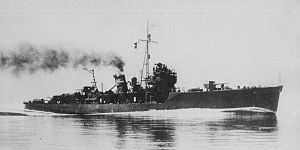Japanese escort Shimushu
 1940 | |
| Career | |
|---|---|
| Name: | Shimushu |
| Laid down: | 29 November 1938 |
| Launched: | 13 December 1939 |
| Commissioned: | 30 June 1940 |
| Decommissioned: | 16 June 1959 |
| Struck: | 5 October 1945 |
| Fate: | Sold to the Soviet Union, 5 July 1947 |
| General characteristics | |
| Class and type: | Shimushu-class escort ship |
| Displacement: | 870 long tons (880 t) (standard) |
| Length: | 77.7 m (254 ft 11 in) |
| Beam: | 9.1 m (29 ft 10 in) |
| Draft: | 3.05 m (10 ft 0 in) |
| Speed: | 19.7 kn (36.5 km/h; 22.7 mph) |
| Complement: | 150 |
| Armament: | 3 × 120 mm (4.7 in)/45 cal dual purpose guns Up to 15 × 25 mm (0.98 in) AA guns 6 × depth charge throwers Up to 60 × depth charges 1 × 80 mm (3.1 in) mortar |
Shimushu (占守) was lead ship of its class, the foundation of all of Japan's kaibokan.
Shimushu participated in the landings in Thailand, escorting the 55th IJA Infantry Division to landings at Nakhon on 8 December 1941. Shimushu also escorted various other invasion convoys to Malaya, Sumatra, and Palembang. Using her sonar, she located the British battlecruiser HMS Repulse on 29 January 1942, being the first ship to locate the submerged wreck.
Shimushu participated in the HI-40 convoy disaster of 19-24 February 1944, in which all six oilers that were escorted by her — and only her, as she was the lone escort vessel — were torpedoed and sunk by the American submarines USS Grayback and Jack. After that convoy disaster, the Naval General staff discontinued assigning only one escort to convoys and organized larger convoys with more escorts.
Shimushu participated in the TA No. 2 and 3, the Japanese effort to hold Leyte island, and claimed one of the five B-25 Mitchell medium bombers lost in the first wave. On 25 November, Shimushu was torpedoed by USS Haddo and lost her bow, and was repaired by 20 January 1945.
Shimushu spent more than a year on repatriation duty and was ceded to the Soviet Union on 5 July 1947.
Served in Soviet Pacific Ocean Fleet as patrol ship EK-31 (1947), dispatch ship PS-25 (1948), repair ship PM-74 (1957). Decommissioned on May 16, 1959 and scrapped.
References
| ||||||||||